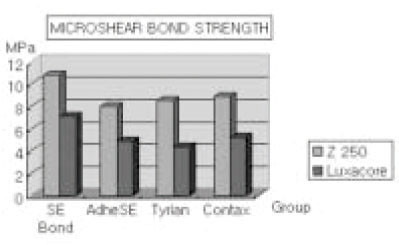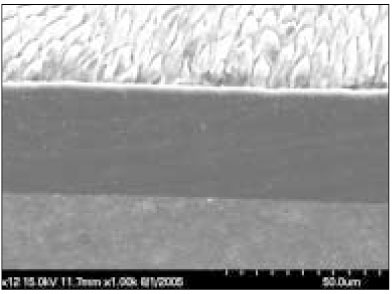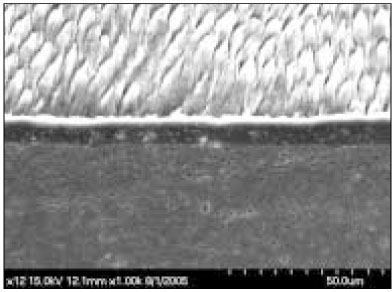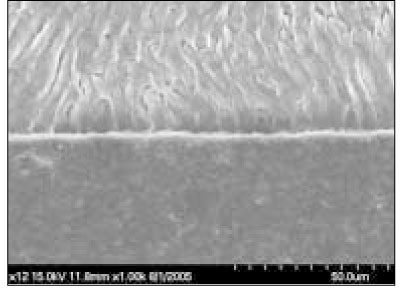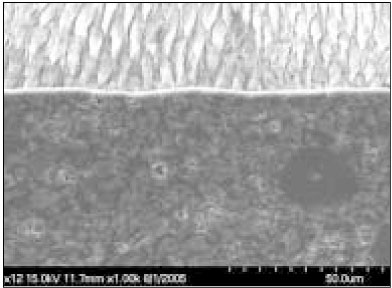J Korean Acad Conserv Dent.
2007 May;32(3):169-179. 10.5395/JKACD.2007.32.3.169.
Enamel adhesion of light- and chemical-cured composites coupled by two step self-etch adhesives
- Affiliations
-
- 1Dental Center, Chung Ang University Hospital, Korea.
- 2Department of Conservative Dentistry, College of Dentistry, Chosun University, Korea. ygcho@chosun.ac.kr
- KMID: 2175864
- DOI: http://doi.org/10.5395/JKACD.2007.32.3.169
Abstract
- This study was to compare the microshear bond strength (microSBS) of light- and chemically cured composites to enamel coupled with four 2-step self-etch adhesives and also to evaluate the incompatibility between 2-step self-etch adhesives and chemically cured composite resin. Crown segments of extracted human molars were cut mesiodistally, and a 1 mm thickness of specimen was made. They were assigned to four groups by adhesives used: SE group (Clearfil SE Bond), AdheSE group (AdheSE), Tyrian group (Tyrian SPE/One-Step Plus), and Contax group (Contax). Each adhesive was applied to a cut enamel surface as per the manufacturer's instruction. Light-cured (Filtek Z250) or chemically cured composite (Luxacore Smartmix Dual) was bonded to the enamel of each specimen using a Tygon tube. After storage in distilled water for 24 hours, the bonded specimens were subjected to microSBS testing with a crosshead speed of 1 mm/minute. The mean microSBS (n=20 for each group) was statistically compared using two-way ANOVA, Tukey HSD, and t test at 95% level. Also the interface of enamel and composite was evaluated under FE-SEM. The results of this study were as follows; 1. The microSBS of the SE Bond group to the enamel was significantly higher than that of the AdheSE group, the Tyrian group, and the Contax group in both the light-cured and the chemically cured composite resin (p < 0.05). 2. There was not a significant difference among the AdheSE group, the Tyrian group, and the Contax group in both the light-cured and the chemically cured composite resin. 3. The microSBS of the light-cured composite resin was significantly higher than that of the chemically cured composite resin when same adhesive was applied to the enamel (p < 0.05). 4. The interface of enamel and all 2-step self-etch adhesives showed close adaptation, and so the incompatibility of the chemically cured composite resin did not show.
Figure
Cited by 1 articles
-
Effect of pre-heating on some physical properties of composite resin
Myoung Uk Jin, Sung Kyo Kim
J Korean Acad Conserv Dent. 2009;34(1):30-37. doi: 10.5395/JKACD.2009.34.1.030.
Reference
-
1. Bouillaguet S, Gysi P, Wataha JC, Ciucchi B, Cattani M, Godin CH, Meyer JM. Bond strength of composite to dentin using conventional, one-step and self-etching adhesive systems. J Dent. 2001. 29:55–61.
Article2. Miyazaki M, Sato M, Onose H. Durability of enamel bond strength of simplified bonding systems. Oper Dent. 2000. 25:75–80.
Article3. De Munck J, Van Meerbeek B, Satoshi I, Vargas M, Yoshida Y, Armstrong S, Lambrechts P, Vanherle G. Microtensile bond strengths of one- and two-step self-etch adhesives to bur-cut enamel and dentin. Am J Dent. 2003. 16:414–420.4. Miyazaki M, Hinoura K, Honjo G, Onose H. Effect of self-etching primer application method on enamel bond strength. Am J Dent. 2002. 15:412–416.5. Inoue S, Vargas MA, Abe Y, Yoshida Y, Lambrechts P, Vanherle G, Sano H, Van Meerbeek B. Microtensile bond strength of eleven contemporary adhesives to enamel. Am J Dent. 2003. 16:329–334.6. Toledano M, Osorio R, de Leonardi G, Rosales-Leal JI, Ceballos L, Cabrerizo-Vilchez MA. Influence of self-etching primer on the resin adhesion to enamel and dentin. Am J Dent. 2001. 14:205–210.7. Hannig M, Reinhardt KJ, Bott B. Self-etching primer vs phosphoric acid: an alternative concept for composite-to-enamel bonding. Oper Dent. 1999. 24:172–180.8. Kanemura N, Sano H, Tagami J. Tensile bond strength to and SEM evaluation of ground and intact enamel surfaces. J Dent. 1999. 27:523–530.
Article9. Watanabe I, Nakabayashi N, Pashley DH. Bonding to ground dentin by a Phenyl-P self-etching dentin primer. J Dent Res. 1994. 73:1212–1220.
Article10. Hayakawa T, Kikutake K, Nemoto K. Influence of self-etching primer treatment on the adhesion of resin composite to polished dentin and enamel. Dent Mater. 1998. 14:99–105.
Article11. Kiremitci A, Yalcin F, Gokalp S. Bonding to enamel and dentin using self-etching adhesive systems. Quintessence Int. 2004. 35:367–370.12. Tay FR, Pashley DH. Aggressiveness of contemporary self-etching systems. I: Depth of penetration beyond dentin smear layers. Dent Mater. 2001. 17:296–308.13. Tay FR, Pashley DH, King NM, Carvalho RM, Tsai J, Lai SCN, Marquezini L. Aggressiveness of self-etch adhesives on unground enamel. Oper Dent. 2004. 29:309–316.14. Frankenberger R, Kramer N, Petschelt A. Long-term effect of dentin primers on enamel bond strength and marginal adaptation. Oper Dent. 2000. 25:11–19.15. Latta MA, Barkmeier WW, Triolo PT, Cavel WT, Blankenau RJ. One year clinical evaluation of the Clearfil Liner Bond 2 system. J Dent Res. 1997. 76:162. Abstract no. 1186.16. Kubo S, Yokota H, Sata Y, Hayashi Y. Microleakage of self-etching primers after thermal and flexural load cycling. Am J Dent. 2001. 14:163–169.17. Cho YG, Cho KC. Marginal microleakage of self-etching primer adhesives and a self-etching adhesive. J Korean Acad Conserv Dent. 2002. 27:493–501.
Article18. Sanares AM, Itthagarun A, King NM, Tay FR. Adverse surface interactions between one-bottle light-cured adhesives and chemical-cured composites. Dent Mater. 2001. 17:542–556.
Article19. Hu X, Marquis PM, Shortall AC. Two-body in vitro wear study of some current dental composites and amalgam. J Prosthet Dent. 1999. 82:214–220.
Article20. Cheong C, King NM, Pashley DH, Ferrari M, Toledano M, Tay FR. Incompatibility of self-etch adhesives with chemical/dual-cured composites: two-step vs one-step systems. Oper Dent. 2003. 28:747–755.21. Tay FR, Pashley DH, Peters MC. Adhesive permeability affects composite coupling to dentin treated with a self-etch adhesive. Oper Dent. 2003. 28:610–621.22. Tay FR, Pashley DH, Suh BI, Carvalho RM, Miller MB. Single-step self-etch adhesives behave as permeable membranes after polymerization. Part I. Bond strength and morphologic evidence. Am J Dent. 2004. 17:271–278.23. Tay FR, Pashley DH, Yiu CK, Sanares AM, Wei SH. Factors contributing to the incompatibility between simplified-step adhesives and chemically-cured or dual-cured composites. Part I. Single-bottle self-etching adhesive. J Adhes Dent. 2003. 5:27–40.24. Tay FR, Suh BI, Pashley DH, Prati C, Chuang SF, Li F. Factors contributing to the incompatibility between simplified-step adhesives and self-cured or dual-cured composites. Part II. Single-bottle, total-etch adhesive. J Adhes Dent. 2003. 5:91–105.25. Yoshiyama M, Sano H, Ebisu S, Tagami J, Ciucchi B, Cavalho RM, Johnson MH, Pashley DH. Regional strengths of bonding agents to cervical sclerotic dentin. J Dent Res. 1996. 75:1404–1413.
Article26. Sano H, Shono T, Sonoda H, Takatsu T, Ciucchi B, Carvalho RM, Pashley DH. Relationship between surface area for adhesion and tensile bond strength-evaluation of a microtensile bond test. Dent Mater. 1994. 10:236–240.
Article27. Cho YG, Kim JJ. Microshear bond strength of adhesives according to the direction of enamel rods. J Korean Acad Conserv Dent. 2005. 30:344–351.
Article28. Cheong C, King NM, Pashley DH, Ferrari M, Toledano M, Tay FR. Incompatibility of self-etch adhesives with chemical/dual-cured composites: two-step vs one-step systems. Oper Dent. 2003. 28:747–755.29. Yamauchi J. Study of dental adhesive containing phophoric acid methacrylate monomer. Jap J Dent Mater. 1986. 5:144–154.30. Lopes GC, Marson FC, Vieira LCC, de Andrada MAC, Baratieri LN. Composite bond strength to enamel with self-etching primers. Oper Dent. 2004. 29:424–429.31. Yamada T, Sugizaki J. Basic properties and clinical application of the Clearfil SE Bond. Preceeding of the International Kuraray Symposium. 2000. Osaka: 1–6.32. Perdigao J, Lopes L, Lambrechts P, Leitao J, Van Meerbeek B. Effects of a self-etching primer on enamel shear bond strengths and SEM morphology. Am J Dent. 1997. 10:141–146.33. Reifeis PE, Cochran MA, Moore BK. An in vitro shear bond strength study of enamel/dentin bonding systems on enamel. Oper Dent. 1995. 20:174–179.34. Swift EJ Jr, Perdigao J, Heymann HO, Ritter AV. Shear bond strength of one-bottle adhesives to moist enamel. J Esthet Dent. 1999. 11:103–107.
- Full Text Links
- Actions
-
Cited
- CITED
-
- Close
- Share
- Similar articles
-
- Comparative enamel bond strength between light- and dual-cured composites bonded by self-etching adhesives
- The effects of fluoride releasing orthodontic sealant on the shear bond strength of light-and chemical-cured orthodontic resins
- Microshear bond strength of adhesives according to the direction of enamel rods
- The micro-tensile bond strength of two-step self-etch adhesive to ground enamel with and without prior acid-etching
- Shear bond strength of metal brackets bonded with light-cured adhesive: an in vitro comparative study

